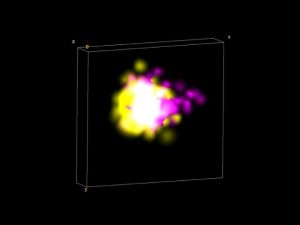

A study co-led by researchers from the Neurobiology of Dementia group at the Research Institute of Hospital de la Santa Creu i Sant Pau – IIB Sant Pau, published in the prestigious journal Neuron, of Cell group, describes that harmful proteins that accumulate in the brains of people with Alzheimer’s disease spread through synapses.
The research, led by Professor Tara Spires-Jones’ team at the UK Dementia Research Institute at the University of Edinburgh and carried out by IIB Sant Pau in collaboration with the Institute of Advanced Chemistry of Catalonia (IQAC) of the Spanish National Research Council (CSIC), provides new evidence that could be the key to stopping the progression of Alzheimer’s disease. The study was conducted under the European COEN project, funded by CIBERNED and coordinated by Dr. Alberto Lleó, a researcher in the Neurobiology of Dementia group at IIB Sant Pau and head of the Neurology department of the same hospital.
The accumulation of the Tau protein in neurons in the form of neurofibrillary tangles is one of the most characteristic aspects of Alzheimer’s disease. The deposits of this protein spread through brain circuits, disrupting communication between brain cells, leading to altered brain functions. It is the first time that these abnormal forms can be observed in human brains spreading through synapses.
Synapses are the points of connection between brain cells that allow chemical and electrical messages to flow, and this process is vital for normal brain function. Synapses are lost in Alzheimer’s disease, and the loss of these connections significantly predicts memory loss and other intellectual functions in these patients.
The research team examined over one million synapses from 42 individuals using innovative techniques with high-powered and super-resolution microscopes in collaboration with the IQAC-CSIC, which allowed them to visualize the flow of proteins within individual synapses. The researchers were able to observe that small deposits of the Tau protein, known as oligomers, were present on both sides of the synapses in individuals who died from Alzheimer’s. That is, both in the neuron that sends signals and in the one that receives them, indicating that synapses have the ability to transmit toxic Tau proteins from one part of the brain to another.
According to Dr. Sílvia Pujals, Ramón y Cajal researcher at IQAC-CSIC, “this study demonstrates how super-resolution microscopy, capable of visualizing nano-scale structures, has great potential in the study of the molecular mechanisms involved in diseases.”
These data reinforce the hypothesis that stopping the spread of the toxic form of the Tau protein in synapses may be a promising strategy for treating Alzheimer’s disease in the future, explains Dr. Lleó. “If we can block the passage of the most pathological form of the Tau protein, which are the oligomers, from one neuron to another, we could probably stop the progression of Alzheimer’s disease. Because we know that the progression of the disease is related to the expansion of the protein throughout the brain.”
The principal investigator, Professor Tara Spires-Jones from the UK Dementia Research Institute at the University of Edinburgh, indicates that “We have known for over 30 years that tangles spread through the brain during Alzheimer’s disease, but how they spread has remained a mystery. Wherever tangles appear in the brain, neuron death follows, contributing to the decline in cognitive ability. Stopping the spread of toxic tau is a promising strategy to stop the disease in its tracks.”
Dr. Sònia Sirisi Dolcet, postdoctoral researcher in the Neurobiology of Dementia group at the IIB Sant Pau, explains that Tau oligomers, which travel through synapses, “are a very early form in the aggregation process of this protein. That is, they are present in very early stages of Alzheimer’s disease.” Therefore, if strategies can be developed to prevent the spread of this protein throughout the brain in these early stages, its progression could be prevented or stopped.

Colom-Cadena et al., Synaptic oligomeric tau in Alzheimer’s disease — A potential culprit in the spread of tau pathology through the brain, Neuron (2023), https://doi.org/10.1016/j.neuron.2023.04.020